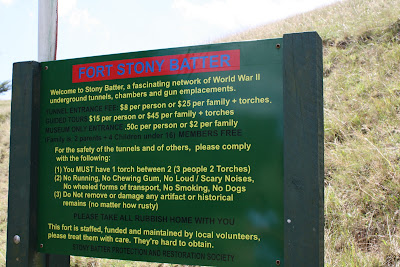Stony Batter was of part of a counter-bombardment battery system progressively being installed in the Hauraki Gulf from the 1930s. Composed of various gun batteries, as well as having observation posts, it was supposed to engage enemy naval forces entering the inner gulf. Next to the gun pits there are 1000 feet of tunnels. These connected the gunpits with each other and with their ammunition stores, a plotting room, an engine room providing electricity, as well as with storerooms and barracks.
The tunnels and underground chambers were quarried by hand, with formwork for the walls and ceilings, then filled with concrete (reinforcing steel was not used due to shortages). Aggregate was obtained from the prominent rocky outcrops, giving Stony Batter its name.


While approved in 1939, construction was delayed for cost reasons until German raiders were sighted in New Zealand waters during 1940-1941, as well as the war entry of Japan in late 1941, suddenly turned it into a high-priority project. As the tides of war turned, only two guns were installed, one in 1944, and one in 1948. The third gun was cancelled before shipment. Never fired except for testing and training purposes, the guns were dismantled and sold for scrap in 1961.
The guns installed at Stony Batter were 9.2-inch (the shells they fired were 9.2" in diameter). Each gun weighed 110-120 tons and its turret had 2-inch steel armour-plating. The barrels weighed 28 tons; they were 442.75" long, and 34.75" in diameter at the breach end. The guns were mounted in concrete pits 40 feet in diameter. A 9.2-inch gun could fire two shells a minute once the crew were trained and if its electricity and hydraulics were working. They could be operated manually; then the maximum rate of fire was a shell every two and half minutes.
We had read about the tunnels and came with strong flashlights to explore on our own. Since we hiked up from the boat, we entered the tunnels near the guns and exited where they were collecting entry fees and passing out flash lights. Oh well, more money for the college fund!
We next moved around to Putiki bay and hiked to Ostend and then took a bus to Onetangi for lunch. We ate at The Beach Front Café and had one of the better meals we've had here so far.
From Waiheke we could see the Auckland skyline, so we voted to check that out next.
Tom










1 comment:
Dear kids,
Followed your land route on Waiheke Island. From Stony Batter to Ostend, WOW that looked like quite a hiking trip. I'm proud of you Tom, Kim must have you in shape at last. Thank God for the winneries, eh? Glad to see at least you took a bus half way back to Onetangi.
Following you along.
Mom
Post a Comment